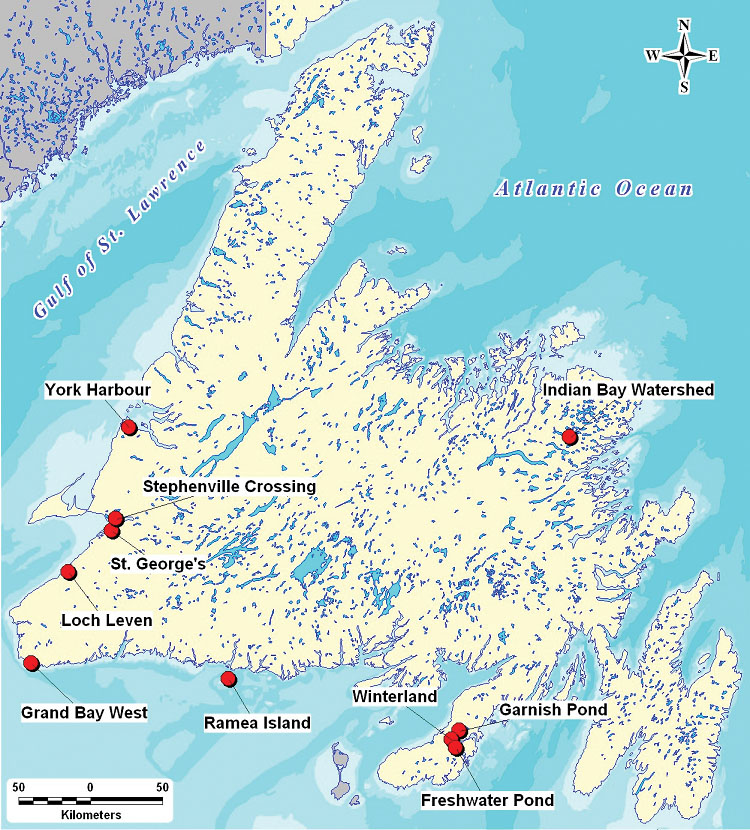Banded Killifish: Newfoundland Population
What you need to know
Under the Species at Risk Act, listed as:
Species of Special Concern (may become threatened or endangered because of a combination of biological characteristics and identified threats)
Under the Newfoundland and Labrador Endangered Species Act, listed as:
Vulnerable Species (has characteristics which make it particularly sensitive to human activities or natural events)
The Species at Risk Act (SARA) came into effect in 2003 and its purpose is: to prevent Canada's wildlife species from being extirpated or becoming extinct; to provide for the recovery of wildlife species that are extirpated, endangered or threatened as a result of human activity; and to manage species of special concern to prevent them from becoming endangered or threatened.
In January 2005, the banded killifish species was added to the list of Canadian species at risk of extinction. It is listed as a species of special concern, which means that it may become a threatened or endangered species because of a combination of biological characteristics and identified threats.
Banded killifish play an important role in the freshwater ecosystem of our province, mainly as a food source for some of our fish species, including Atlantic salmon, brook trout, and American eel. Their survival depends on all of us, so we must maintain existing population levels and distributions as well as protect their habitat.
What they look like
The banded killifish is mainly olive in colour and has numerous light and dark vertical bands along its sides. The female’s bands are thin and black in colour and often do not span the full width of the body. The male has pale bands that are closer together and less distinct. The body is long and slender with the average length of adults ranging from 7 to 9 cm.
There are two species of killifish in Newfoundland waters, the banded killifish and the mummichog. They are very similar in appearance and size and are often found schooling together. It may be difficult to distinguish between them.
Where they live

Distribution of banded killifish around the island of Newfoundland.
Data Source: [2008 draft] Management Plan for the Banded Killifish in Newfoundland and Labrador.
Banded killifish are distributed throughout eastern North America, ranging from South Carolina as far north as the Atlantic Provinces. Banded killifish around the island of Newfoundland are at the eastern-most extent of their range. There are currently 10 known documented populations of banded killifish on the island of Newfoundland: Indian Bay Watershed, Garnish Pond, Freshwater Pond, Winterland, Ramea Island, Grand Bay West, Loch Leven, Stephenville Crossing, St. George’s, York Harbour.
Banded killifish are capable of tolerating a wide range of salt water concentrations; however, they usually inhabit freshwater streams and lakes. They are often found in shallow, quiet areas of clear lakes and ponds over sand, gravel or bottoms having an abundance of aquatic vegetation.
Threats and Concerns
The limited distribution of this species around the island and its restricted range, make it particularly susceptible to catastrophic events or localized disturbances. Common threats to banded killifish include:
- Habitat degradation resulting from various industrial developments (road construction, forestry activities, etc.) could negatively impact populations in a sensitive watershed area. With proper mitigation techniques aimed at protecting fish and fish habitat, many adverse effects can be avoided.
- Major disturbances like small motorized water craft activity in the immediate area of a population could be disruptive.
- Banded killifish spawn on aquatic plants (usually late June to mid-August) and due to the importance of aquatic plants to the species’ reproductive cycle, aquatic vegetation removal should be avoided.
- Occasional by-catch of banded killifish within Newfoundland’s eel fishery could be detrimental; proper precautions must be taken since fish handling and exposure to air can impact survival.
For more information, please contact your nearest DFO Office or visit:
- Aquatic Species at Risk: Banded Killifish (Newfoundland)
- Species at Risk Public Registry
- Newfoundland and Labrador Department of Fisheries and Land Resources - Species at Risk
DFO/2008-1442
Cat no: Fs114-12/2008E
ISBN: 978-0-662-48170-6
- Date modified:

